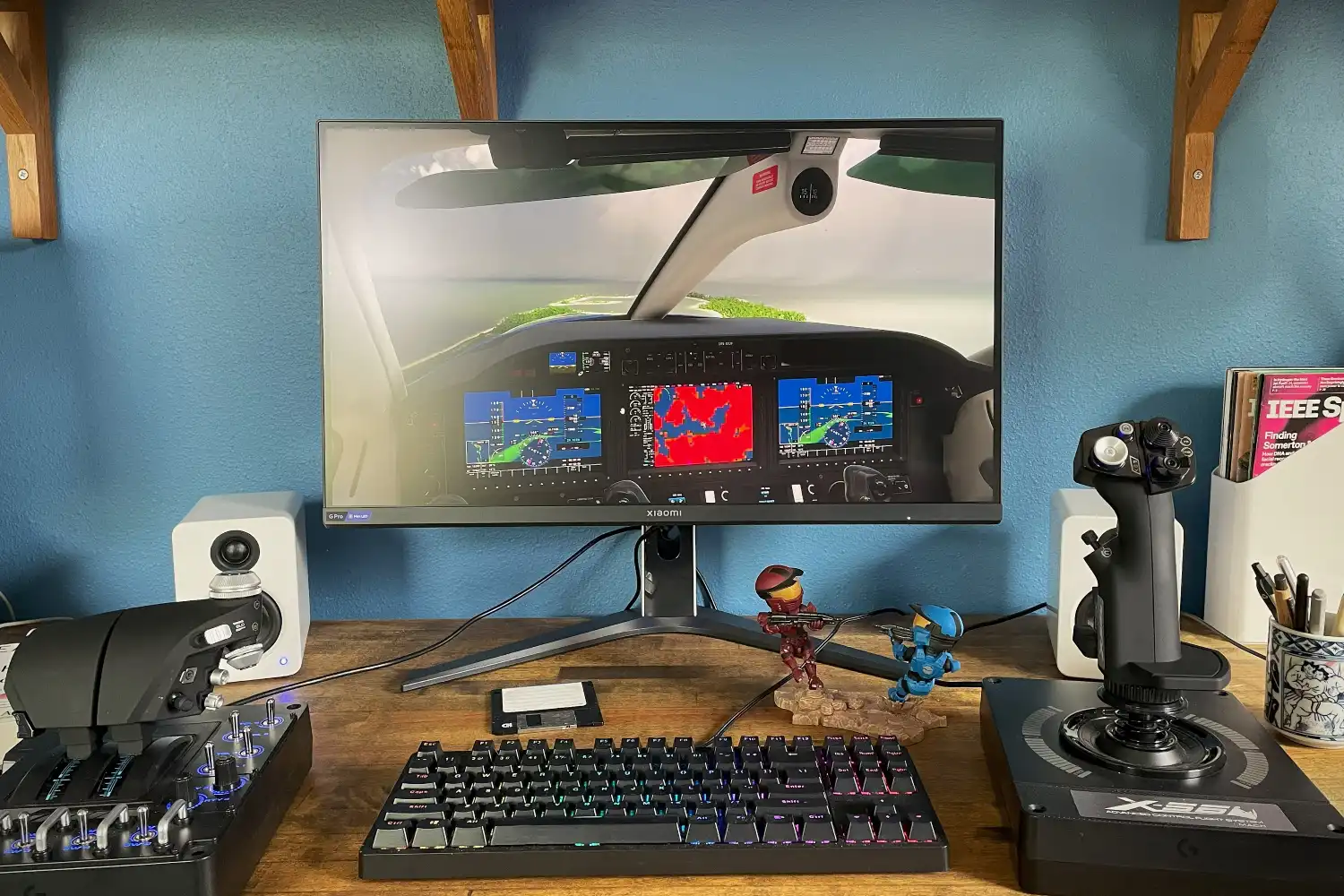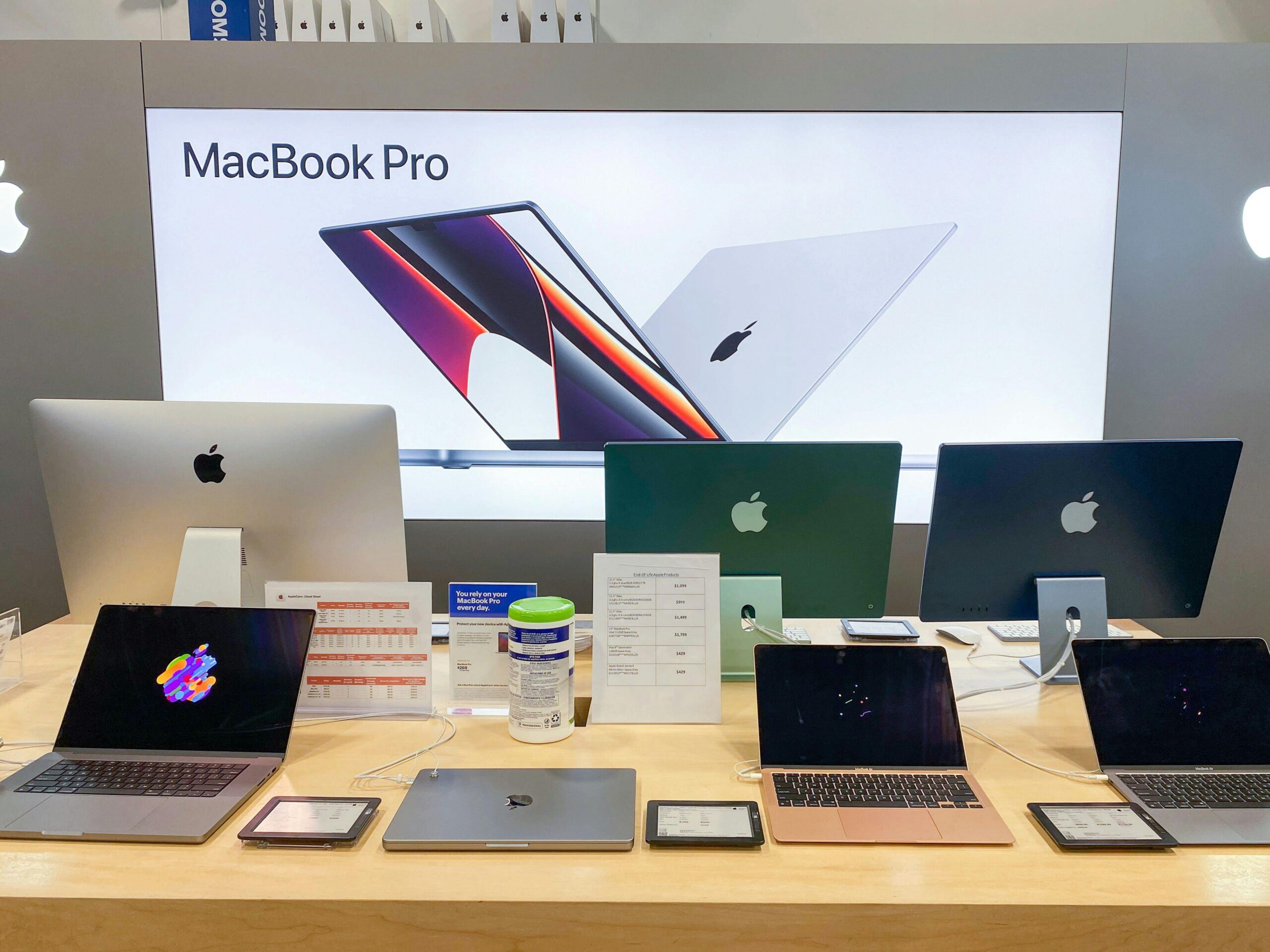Mini-LED monitors are one of the most interesting niches in the monitor market right now. These displays use an array of LED lights behind the screen to dynamically adjust contrast. Although this technology is typically expensive to implement, a few budget options have emerged, such as the Xiaomi G Pro 27i. It’s not much more expensive than models lacking a Mini-LED backlight, either.
Xiaomi G Pro 27i specs and features
Most of the Xiaomi G Pro 27i’s specifications are typical for a 27-inch gaming monitor priced below $500. The 27-inch widescreen panel has a resolution of 2560×1440 and supports a refresh rate of up to 180Hz. There are literally hundreds of monitors available with a similar resolution and refresh rate.
- Display size: 27-inch 16:9 widescreen
- Native resolution: 2560×1440
- Panel type: Fast IPS with Mini-LED backlight with 1,152 dimming zones
- Refresh rate: Up to 180Hz
- Adaptive sync: AMD FreeSync
- HDR: VESA DisplayHDR 1000
- Ports: 2x HDMI 2.0, 2x DisplayPort 1.4, 1x 3.5mm audio out
- VESA mount: 100x100mm
- Speakers: None
- Price: $329.99 MSRP
The Mini-LED backlight is Xiaomi’s secret sauce. Despite its price of just $330, the Xiaomi G Pro 27i features 1,152 dynamic dimming zones. If you wanted that many dimming zones in 2023, you’d have to pay three or four times more than what Xiaomi is asking today.
Xiaomi G Pro 27i design
A glance at the Xiaomi G Pro 27i makes it clear the company’s designers took notes from Alienware. The monitor’s combination of stark white and charcoal-black materials, along with the distinctive retro-futuristic font used by the number “27” found on the back of the display, gives off a vibe similar to Alienware’s distinctive “Legend” design language.
I’ve always felt Alienware’s monitors are among the best-looking in the industry today, so emulating that design is a recipe for success. I was also surprised by how nice the monitor looks and feels given its $330 price. Not only is it attractive, but it also holds up well when handled, as Xiaomi makes use of materials and textures that help the monitor stand out from the crowd. It includes RGB-LED lighting on the rear of the display panel for extra flair, though I didn’t find it to be especially bright.
 Xiaomi ships the monitor with a functional ergonomic stand that adjusts for height, tilt, swivel, and can rotate 90 degrees for use in portrait orientation. Most monitors priced similarly offer a similar range of adjustments, but it’s good to see Xiaomi didn’t sacrifice ergonomics to keep the price low.
Xiaomi ships the monitor with a functional ergonomic stand that adjusts for height, tilt, swivel, and can rotate 90 degrees for use in portrait orientation. Most monitors priced similarly offer a similar range of adjustments, but it’s good to see Xiaomi didn’t sacrifice ergonomics to keep the price low.However, Xiaomi opts for a rather wide stand base which takes up more desk space than necessary. It’s flat, at least, so you can still make some use of the space it occupies, but I prefer the smaller hexagonal stand found on some recent Alienware monitors like the Alienware AW2725QF.
The stand is also more difficult to set up than usual, as it’s not secured with the typical thumb screw but instead with four Phillips-head screws (a screwdriver is provided). A 100x100mm VESA mount is available for use with third-party monitor stands and arms.
Xiaomi G Pro 27i connectivity and menus
The Xiaomi G Pro 27i has two HDMI 2.0 ports and two DisplayPort 1.4 ports for a total of four video inputs. Only the DisplayPort connections can handle the monitor’s full resolution and refresh rate of 180Hz, while the HDMI ports are limited to 144Hz. Ideally, all ports should support the full resolution and refresh rate, but sticking with HDMI 2.0 is a compromise made by many affordable monitors.
While the monitor offers plenty of video connectivity, it lacks USB connectivity — there’s no USB-C, USB-B, or USB-A. This omission isn’t surprising, as many inexpensive monitors skip USB ports altogether. However, with USB-C becoming more popular each year, it would have been nice to see it included. The Innocn 27M2V, a 27-inch 4K Mini-LED monitor, offers a USB-C port.
A 3.5mm audio-out jack rounds out the connectivity options. The Xiaomi does not have built-in speakers.
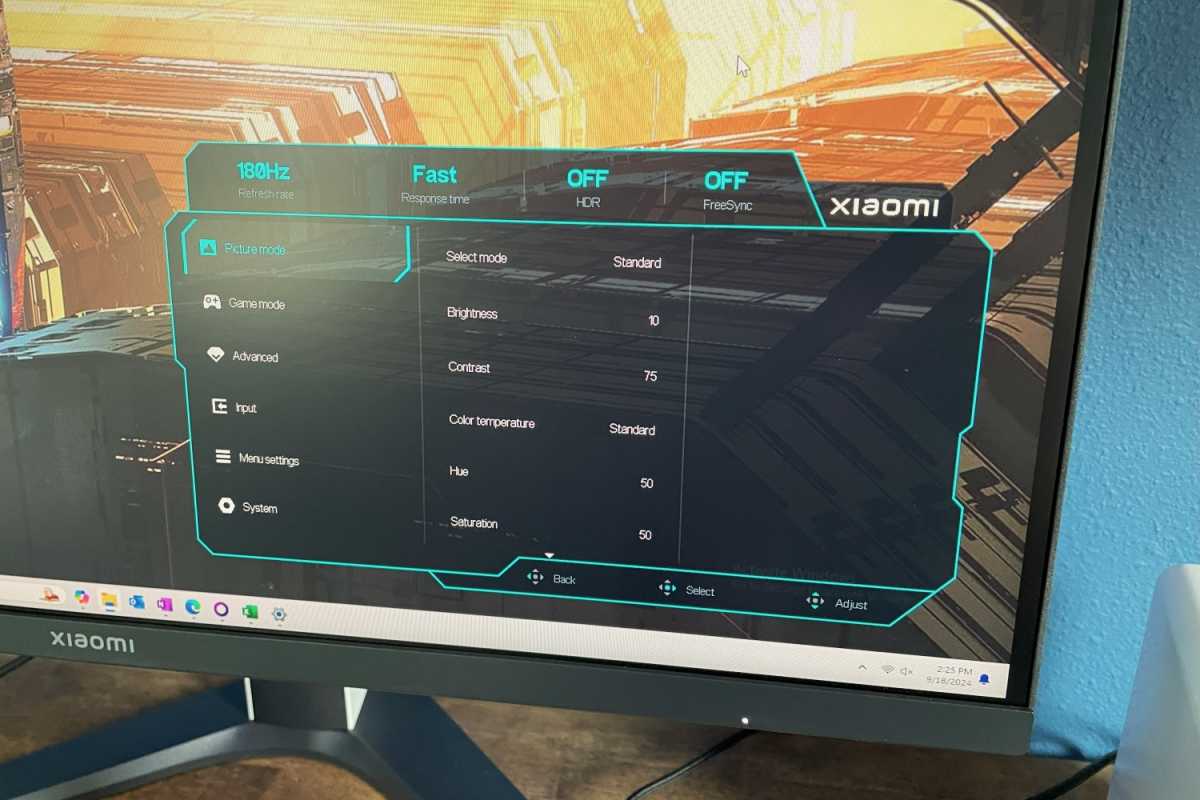
Foundry
The on-screen menu system is controlled via a responsive joystick located on the right side of the monitor. Like many monitor menu systems, Xiaomi relies on small text that can be a bit difficult to read from a distance. However, the monitor offers a good range of options, including image adjustments for color and gamma.
Gaming features are lacking, though: The monitor has a Dark Scene Boost feature to make foes easier to spot in dark areas, but it lacks an on-screen crosshair, timer, or FPS counter. It also doesn’t support the alternative display size and aspect ratio modes found on OLED gaming monitors and lacks any picture-in-picture or picture-by-picture mode.
While the on-screen menu system is good, Xiaomi doesn’t offer a Windows software utility to control the monitor’s settings. Many monitor brands, including Alienware, Acer, Gigabyte, LG, and BenQ, now offer some sort of Windows utility, which is usually more convenient to use than the on-screen menu. Xiaomi’s lack of a Windows utility for this monitor isn’t a big deal if you don’t plan to change settings often, but if you do, it’s a letdown.
Xiaomi G Pro 27i SDR image quality
The Xiaomi G Pro 27i’s Mini-LED backlight allows it to achieve VESA DisplayHDR 1000 certification, which is excellent for an affordable gaming monitor. However, SDR is still the main use case for most PC games and productivity apps, so that’s where we will begin.
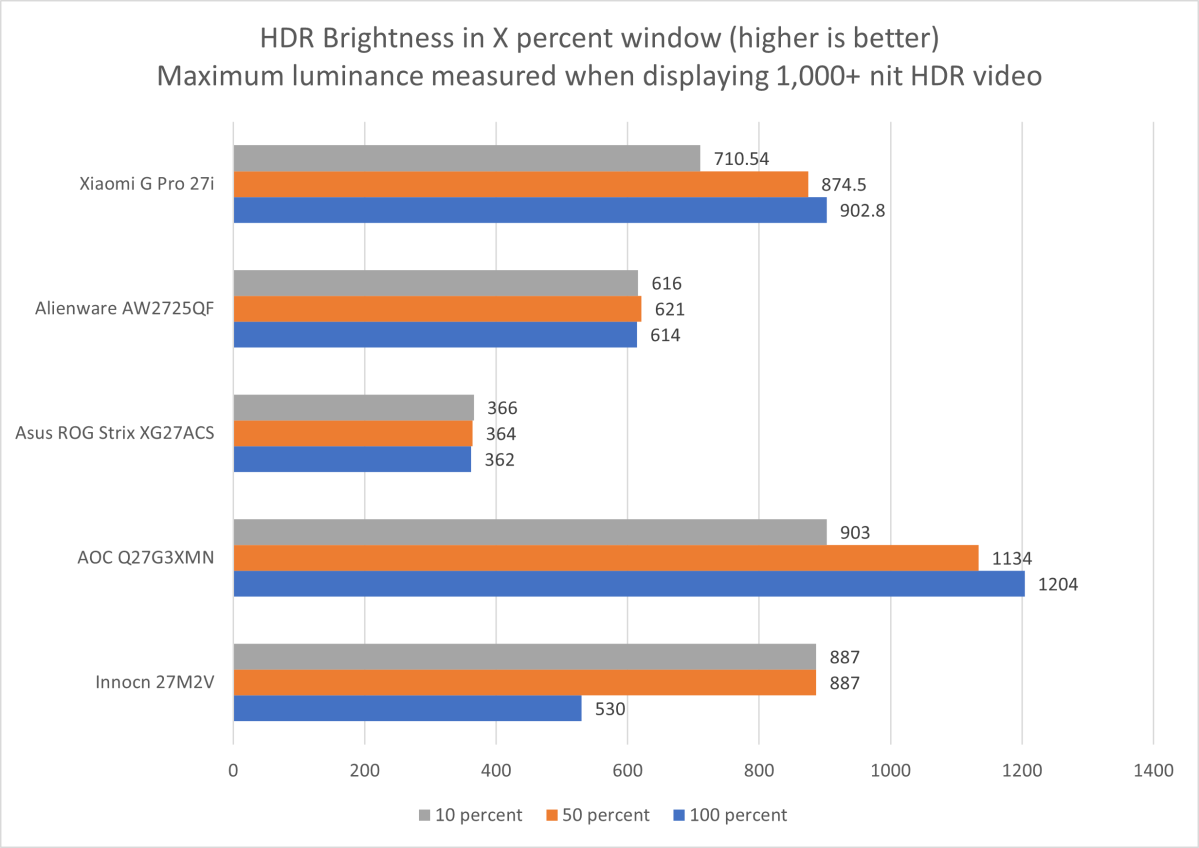
Foundry
The Xiaomi G Pro 27i is exceptionally bright at its maximum setting. I measured a peak brightness of almost 800 nits, which obliterates the competition.
Of course, it’s worth asking whether this level of brightness is useful. In theory, this could be beneficial if you’re using the monitor next to a sunward-facing window or in an extremely bright room, but otherwise, I don’t think this level of SDR brightness is necessary. Personally, I found it comfortable at around 25 percent to 30 percent of its maximum brightness.
Still, if you want bright, Xiaomi delivers.
EZVIZ Dual-Lens cameras are the security you didn’t know you needed

Foundry
The Xiaomi G Pro 27i delivered a respectable contrast ratio of 8,530:1 at 50 percent of its maximum brightness. This is a good result for an affordable monitor, and in many situations, it won’t look much different from an OLED display. Xiaomi’s strong contrast, combined with its brightness, makes it especially well-suited for use in brighter rooms. When used this way, dark portions of the display appear extremely deep, offering a great sense of immersion.
However, the monitor faces stiff competition from the AOC Q27G3XMN, another affordable Mini-LED display. The AOC has far fewer backlight zones than the Xiaomi (336 vs. 1,152), but in testing, the AOC achieved a better contrast ratio at default settings. This was true across both higher and lower brightness levels. The Innocn 27M2V, an older 4K Mini-LED monitor, fell behind the Xiaomi, though it still performed well for the price.
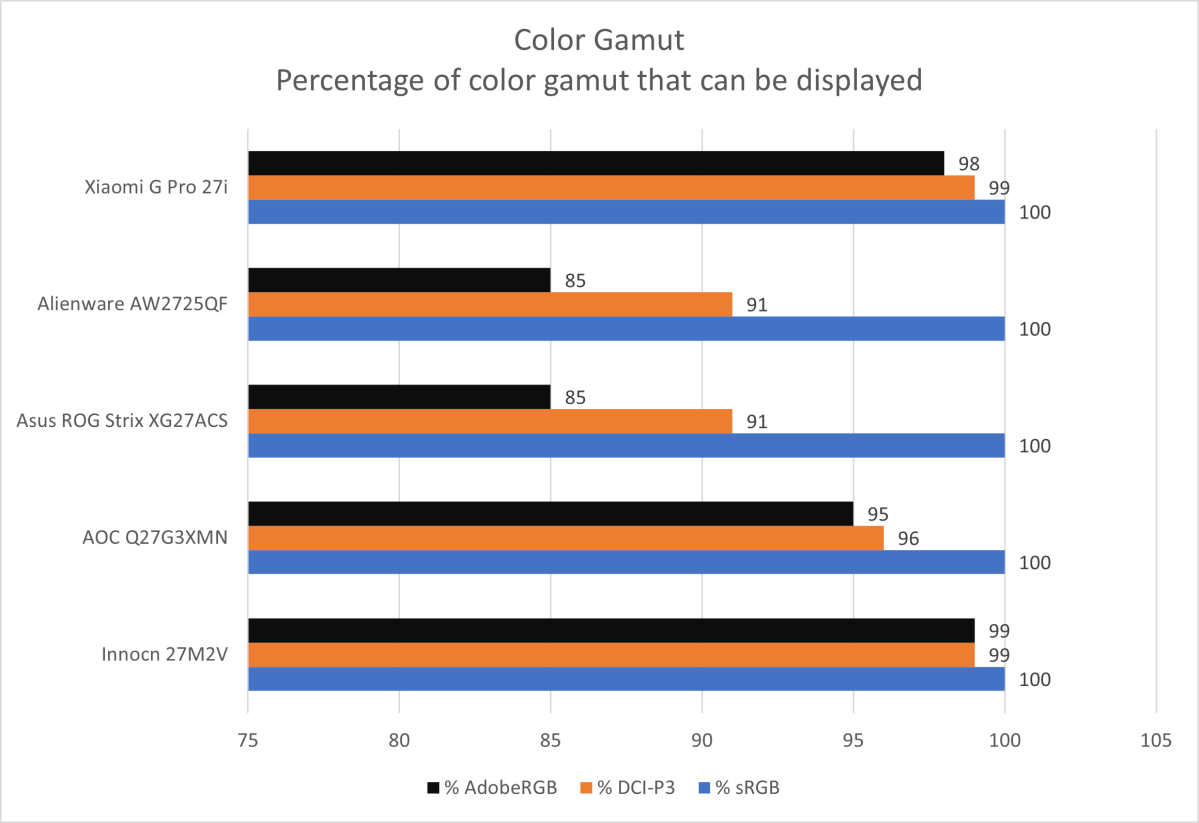
Foundry
Color gamut is arguably the Xiaomi G Pro 27i’s greatest strength, as the monitor has a colorful Quantum Dot panel, which is exceptional at this price point and delivers a color gamut far wider than most competitors. We’re talking 99 percent of DCI-P3 and 98 percent of Adobe RGB. These results are among the best available at any price and defeat even QD-OLED monitors, which many consider the gold standard for a monitor’s color gamut.
The Xiaomi’s excellent color gamut provides vivid, saturated visuals in games, but it’s even more useful for content creators working with photos, videos, or digital art. The monitor allows you to see a wider range of colors than is typical for competitively priced displays. The Innocn 27M2V is a strong rival to Xiaomi in this area and also has 4K resolution (which many content creators will prefer), but it’s roughly $150 more expensive.
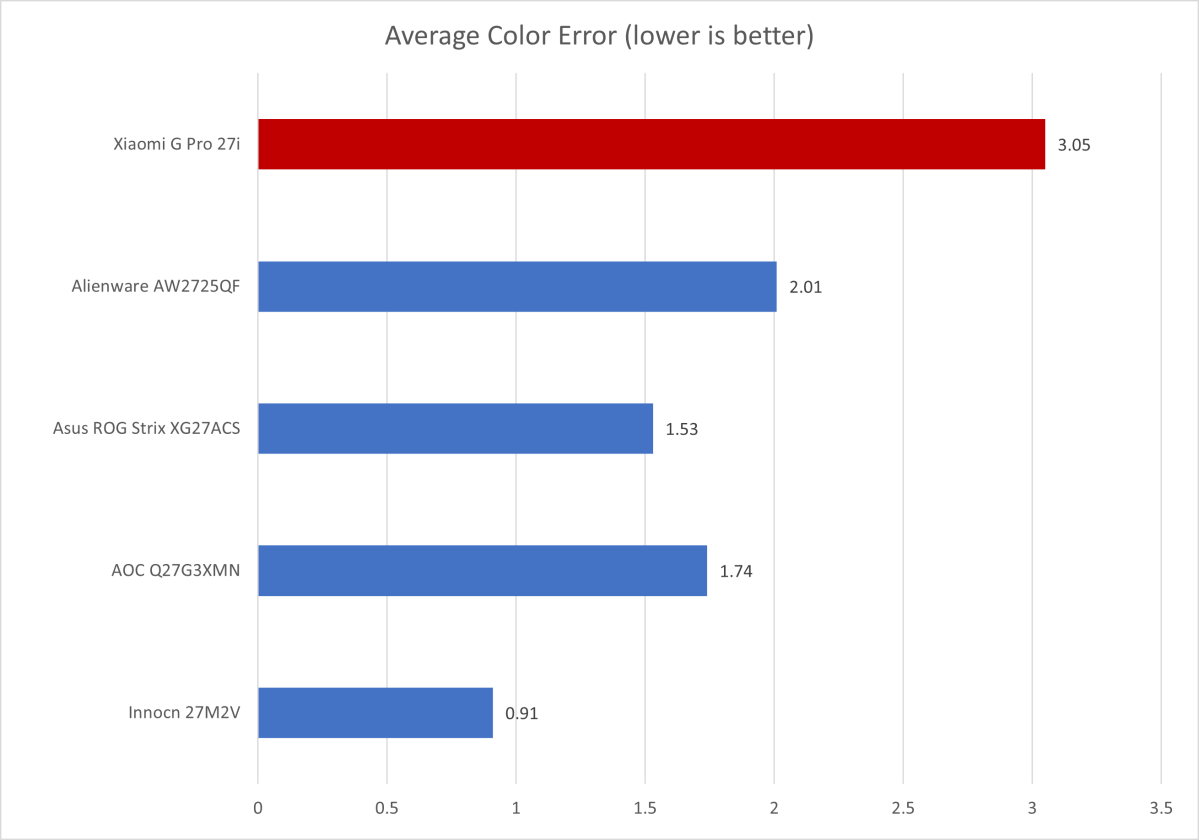
Foundry
Color accuracy, on the other hand, was a weakness, as Xiaomi’s default color accuracy was behind its closest competitors. This can be adjusted with calibration, and I managed to improve the color accuracy, bringing the average color error down to 1.66 with some tweaks. That level of color accuracy is strong, though still not at the top of the pack.
I had some issues with gamma and color temperature. Initially, I measured a default gamma curve of 2.9, which was far off the target of 2.2 and indicated an overly dark image. This didn’t match what I was seeing, so I investigated further. After some troubleshooting, I found that the Mini-LED backlight took a moment to settle into the correct brightness when shifting between gamma test images, which skewed the results. Turning off the dynamic Mini-LED backlight changed the gamma result to 2.3, which is much closer to the target and provides a more accurate image. To be clear, I believe a gamma 2.3 is also what the panel produced with the Mini-LED backlight turned on but, because of how it operated, I couldn’t get a result I trusted.
The default color temperature also skewed warm at 5900K, which can give the image a red or rosy tint. This, too, is adjustable, and you can dial in the color temperature to suit your preference. But I was never able to hit my target color temperature of 6500K: The monitor was always a bit too cool or too warm.
Sharpness is fine. The Xiaomi’s 2560×1440 resolution is a common choice for an affordable 27-inch monitor, providing a pixel density of about 109 pixels per inch. That’s enough to look sharp in most situations, though text can seem slightly pixelated at times. I think 1440p is a solid compromise for an affordable 27-inch monitor, providing good sharpness at a resolution that budget and midrange video cards can handle more easily.
While the Xiaomi G Pro 27i’s SDR image quality is solid, especially for a monitor at its price point, it has strengths and weaknesses. It’s the opposite of a display like the Dell U2724DE. That Dell has image quality that’s good all-around but never the best. The Xiaomi, on the other hand, is exceptional in some areas (like brightness and color gamut) but not so hot in others (like color accuracy and color temperature).
If you want bright, Xiaomi delivers.
Xiaomi G Pro 27i HDR image quality
The Xiaomi G Pro 27i claims VESA DisplayHDR 1000 certification, which is excellent for a monitor at this price point. The monitor mostly lived up to the expectations set by this certification, though it’s not without flaws.
HDR brightness is impressive. It achieved a sustained brightness of up to 902 nits when displaying a full-screen HDR image calibrated for over 1,000 nits. Its HDR brightness levels across the board are excellent for the price, though not as good as the AOC Q27G3XMN.
However, the Xiaomi G Pro 27i’s HDR image quality is hard to beat for the price. This is not only due to its high HDR brightness but also the use of Quantum Dots, which provides an exceptional color gamut that benefits HDR. Overall, the HDR image tends to appear slightly warmer than it should, but not to the extent that most viewers would notice.
There is one notable flaw, though, and it’s common to Mini-LED monitors: blooming. The Mini-LED backlight’s dimming zones are larger than the individual pixels on the display, so when small bright objects appear on a dark background, a noticeable halo can “bloom” around them. The reverse can happen, too — when viewing bright text on a dark screen, the text may appear dimmer than it should. It happens most frequently around text, like subtitles, or small interface elements, like a mini-map in a strategy game.
I expected the Xiaomi’s dimming zones would minimize blooming, but I didn’t find that to be the case. If anything, it appeared to perform worse than the Innocn 27M2V, which also has 1,152 dimming zones, and was merely on par with the AOC Q27G3XMN, which has just 336. This was most noticeable in the case of inverse blooming: In some cases the Xiaomi had a difficult time displaying small, bright objects at an appropriate level of brightness.
Xiaomi G Pro 27i motion performance
The Xiaomi G Pro 27i features a fast IPS display panel with a maximum refresh rate of 180Hz. It also supports AMD FreeSync and Adaptive Sync, which should work unofficially with Nvidia video cards.
Motion performance is good, though your impression will depend on your perspective. The 180Hz refresh rate delivers a much smoother experience than a 60Hz monitor, with less visible ghosting behind small fast-moving objects. However, the Xiaomi’s motion clarity isn’t any better than other monitors with a similar refresh rate.
Testing with scrolling images from games like League of Legends and Dota 2 showed that character sprites and background terrain were easy to make out, but the character names and health bars could be a bit tough to see, especially when they didn’t contrast well with the background. Again, this is typical for a 180Hz display. However, at this price point, it’s possible to find 240Hz monitors that deliver even better motion clarity.
The Mini-LED backlight can also present issues for motion clarity, especially when a small, bright object moves quickly across a dark scene. Certain colors on gray-ish scenes also seem to trigger this behavior. In either case, the blooming around bright objects can make ghosting more noticeable. Additionally, depending on the size of the object and its speed, the transition between backlight zones can sometimes become obvious, giving a “chunky” or uneven appearance to motion.
Should you buy the Xiaomi G Pro 27i?
The Xiaomi G Pro 27i is a good choice if you’re looking for an affordable monitor that delivers solid HDR performance and achieves a class-leading color gamut. In these areas, the monitor is able to match or even surpass the performance of displays priced several times higher, which is, of course, impressive. The Xiaomi is also surprisingly well designed given its budget pricing.
However, like many Mini-LED monitors, the Xiaomi G Pro 27i can’t avoid some common flaws. Despite its 1,152 dimming zones, blooming is still visible around bright objects on a dark screen, and the reverse can occur with dark objects on a bright screen. Motion performance is also just okay, and competitive gamers on a budget may prefer to stick with a 1080p monitor that lacks Mini-LED but offers a higher refresh rate, such as the Alienware AW2724HF.
That leaves the Xiaomi G Pro 27i with a well-defined niche. It’s an affordable choice for HDR games and movies, and a solid pick for content creators who want an exceptional color gamut at a low price.

